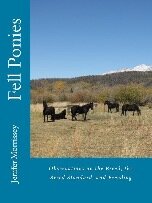What Fell Ponies Have Taught Me About Wild Horses, and Vice Versa
/It was a cool overcast early spring day when I joined a couple of dozen other people to round up some wild horses. I felt it would be a once-in-a-lifetime experience, and I admit when I came home I was on a high after spending all day outdoors outside the reach of phones and the world wide web and watching the movement of equines.
My Three Sisters herd traversing the hill at high elevation.
When I was once again connected to the greater world, I was asked if the wild horses had taught me anything about Fell Ponies. For me, it was actually the other way around. All of my time with Fells running on a large landscape taught me a lot about how the wild horses would and did move as we tried to encourage them to go where we wanted. I knew I didn’t need to be up close but instead be a presence in an area to keep them heading away from me. I also have learned that my ponies can see and sense my location usually long before I know where they are, so I am lucky if I can spot them. Fortunately I have a few ponies who like to let me see them before hiding again with their herd mates so I know roughly where they are.
Willowtrail Spring Maiden barely visible on the ridge. As soon as she felt me see her, she returned to her herd out of sight. I was thankful to know where they were!
My ponies have also taught me that going across and up or down rough terrain is no issue for them, unlike the humans trying to follow them. I can’t count the number of times my ponies have - after I have greeted them on the hill - headed down towards the barn at a speed and on a path that I would be afraid to try to copy. I also am always aware that while my ponies will give me an opportunity to halter them and lead them down, they will also occasionally - if I don’t take advantage of the offer on their schedule - head away from me with focused intention at a moment’s notice. I watched the wild horses make similar decisions when they didn’t like the options they were being given by the humans in their landscape. To be fair about my ponies, as often as they head away from me on the hill, they will also walk with me to the barn untethered.
Wild horses moving away from me like they were supposed to.
Upon a few more hours reflection on the roundup day, I did discover one thing the wild horses taught me that I could use in my stewardship of my ponies. It was the timing of foaling. They were choosing March and April, and I have been trying for April and May. I can see the logic in their choice, given the persistent drought conditions we find ourselves in here and when adequate green grass is available to nourish lactating mares.
While it may have been a once-in-a-lifetime experience rounding up wild horses, I came away firmly with the realization that my ponies give me similar experiences regularly. I count myself very fortunate indeed.
© Jenifer Morrissey, 2025




















